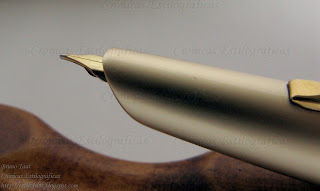Pen review: Sailor Clear Candy (2011).
This pen, with its 16 different decorations, was marketed on the occasion of the 100th anniversary of the company Sailor. However, these pens are, in actual terms, variations on the former A. S. Manhattaner line of pens, as No Pen Intended blog author pointed out some weeks ago.
The reviewed unit is transparent with white and brown accents.

1. Appearance and design. (7.0/10)
Informal looking pen in any of the decorations. It is made of plastic and has no frills save for the screw to attach cap and barrel—an unusual feature on inexpensive pens.
Basically, this is a cartridge-converter pen with a rigid steel nib. Despite its appearance, it cannot easily be transformed into an eyedropper pen.
2. Construction and quality. (7.5/10)
As is often the case with Japanese pens, the construction quality is very good and all the elements fit well. The only negative aspect might be the cheap looking materials of the body. Despite that, though, there are no abnormal marks or scratches due to the regular use of the pen.
The cap of this model (demonstrator with brown and white accents) is decorated with this retro-looking Sailor logo.
3. Weight and dimensions. (9.0/10)
Nothing in the size and weight or in the shape of this pen is a problem for a good performance. As an all plastic pen, it is very light and the balance —either posted or unposted— is always correct.
These are the dimensions:
Diameter: 12.5 mm.
Length closed: 135 mm.
Length open: 121 mm.
Length posted: 153 mm.
Weight: 11.2 g (dry).
Ink deposit: 1.1 ml (cartridge)/0.7 ml (converter).
4. Nib and writing performance. (8.5/10)
Only one nib is available for the whole line of pens. It is a rigid F point made of steel, tipped, labeled as F-2 by Sailor. It is simple and reliable. Not prone to dry out, and not particularly wet or dry. Just as expected on an inexpensive pen.
The F-2 nib is common to a number of inexpensive Sailor pens.
5. Filling system and maintenance. (8.0/10)
As is the case with most cartridge-converter pens, there is no real problem in cleaning it. Nib and feed are attached to the section by friction, and it is very easy to remove them.
The only problem in some markets —certainly not in Japan— might be the difficulty to find Sailor proprietary cartridges and converters. The later is not provided with the pen (JPY 525).
The transformation into an eyedropper is not straight forward. The bottom jewel is a half-spherical piece that is not really sealed into the barrel. As a result, any liquid inside would leak out through it.
The Sailor Clear Candy equipped with a Sailor converter.
6. Cost and value. (6.0/10)
In Japan, this pens costs JPY 1050, which seems a bit expensive for what it actually offers. This is just a correct pen, reliable; whose only selling points are the not-so-exciting decoration and a screw-on cap.
Two alternatives to this Sailor pen are the Platinum Plaisir –a Platinum Preppy with aluminum body and two nib point options (JPY 1050)--, and the Pilot Vortex—screw-on cap and two nib points (JPY 1575).
7. Conclusion. (46/60=77/100)
Good performing pen, but there are similarly priced pens in the Japanese market with more attractive looks and more nib options.














































